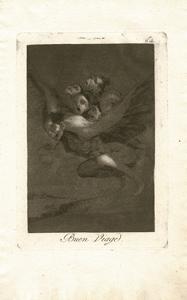In the Classroom
 Staller envisioned and chose the works for the Mead Art Museum's recent exhibition Goya: Prints of Darkness—including this 1803 Goya etching Buen Viage—and took her class to see the show. |
Course: “Witches, Vampires and Other Monsters”
Instructor: Natasha Staller, professor of the history of art
Class size: 25
Listed in: Art and the history of art, European studies and women’s and gender studies
Staller answers three questions about her popular course—and argues that Sharon Stone is more terrifying than Nosferatu.
Interview by Katherine Duke ’05
Q What qualities make a monster?
A I’m still trying to figure it out. Students in the course see a silent film, Nosferatu. From the first millisecond, you see this character as obviously monstrous: how he looks, walks and gestures; the shadows; his environment. He’s extraordinarily attenuated. He moves in a very, very rigid way. Nosferatu carries the plague, the Black Death. Everything about him screams “monster,” screams “other”-ness. Later in the semester, we also see what, to me, is one of the most terrifying films ever made: Basic Instinct, with Sharon Stone. I can’t believe I’m forcing myself to see this movie again; I just can’t bear to see the ending. But I feel morally bound to read and see everything again before I teach it. I can’t stand it! She looks so angelic. She looks so clean. She’s so diabolical.
Q How does the course relate to women’s studies?
A I’m a super-happily-married, eyeliner-wearing feminist, and my work often ends up addressing powerful, dangerous women. Witches certainly were that. And some other forms of monsters were that. As the scourge of syphilis raised its head [in the 19th century], it was ubiquitously believed that only women were carriers, and so you get the trope of the femme fatale, which then was understood to be literally a fatal woman who would kill.
Q Popular culture seems obsessed with vampires, werewolves and witches. Is that why some students are drawn to your class?
A Some clearly were coming out of that; some out of interest in video games, anime, religion, the witch trials in Salem. There are political scientists in the room, thinking about Abu Ghraib. There are always people from LJST—because we study the [Spanish] Inquisition and trials. And then, of course, there are a lot of students who love the art.
See the course syllabus. Read Duke’s extended interview with Staller.
Image courtesy of Mead Art Museum